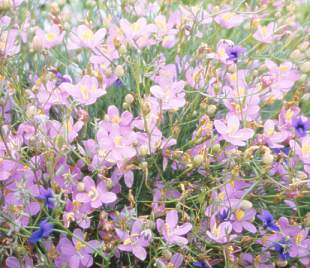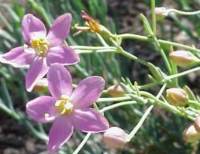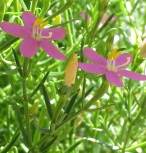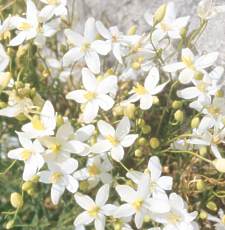Chironia linoides
Chironia linoides L.
Family: Gentianaceae
Common names: Cape centaury, bitterwortel (Afrikaans)
Introduction

Flowering during the warm summer months, usually from Christmas until late February, Chironia linoides adds splashes of colour to the garden. The plants at Kirstenbosch were collected as cuttings in the Cederberg, attracting our attention because they were flowering bright pink and pure white in a ditch along a gravel road, while most of the surrounding veld was brown and dormant during the long, dry summer.
Description
Description
Chironia linoides is a low, shrubby perennial that grows about 30 cm high and wide. It produces many thin branches and forms a small, dense bush that often falls over to one side. The stems and narrow leaves are slightly succulent and blue-green in colour.

During mid-summer a single flower forms at the tip of each of the many stems, so numerous that they cover the whole bush. Firstly, small green buds appear, these swell in size and slowly reveal the colour of the petals that unfold around the large yellow anthers in the middle of the flower. Although the flowers are usually bright pink, pure white forms do occasionally occur.
Distribution and habitat
Distribution description

Chironia linoides occurs naturally throughout the winter rainfall areas of the Cape, from Namaqualand to the Cape Peninsula, Bredasdorp and Oudtshoorn, where it is most often found growing on sandy or marshy flats and slopes.
It is possible to confuse C. linoides with two other well known and pretty flowers in the same family, the sea rose Orphium frutescens and the Christmas berry Chironia baccifera that both grow wild in the Cape and produce bright, shiny pink flowers in midsummer.
Derivation of name and historical aspects
History
The genus Chironia is named after Chiron, the god Centaur of Greek mythology, who studied medicine, astronomy, music and other arts and was a skilled herbalist. He was accidentally shot and killed by Zeus who then put him in the sky as Alpha and Beta Centauri, the pointer stars for the Southern Cross. The common name, centaury, has the same origin, and is applied to most species of Chironia, as well as to species in the genus Centaurium. The plants of these genera are also extremely bitter, hence the Afrikaans common name, bitterwortel meaning bitter root. The species name linoides means resembling the genus Linum (flax).
There are about 30 species in the genus Chironia, found throughout tropical and subtropical Africa and Madagascar, and 16 species can be found in southern Africa.
Growing Chironia linoides
Grow

Chironia linoides is not strong enough to make a grand display by itself, but is excellent for creating small pockets of colour in the rockery, and as a filler between restios or mixed with other perennials like Orphium frutescens, Lobelia valida, diascias and geraniums that flower at the same time. It likes full sun, well-drained soil and water throughout the year. Plants usually last for about 2 to 3 years before they become untidy and need to be replaced.
Chironia linoides is easy to propagate from cuttings taken at almost any time of the year. Tip cuttings made of new growth usually root within a month and young plants are ready for planting after about 4 months growth. For a display in midsummer, cuttings should be made in autumn, grown on during winter and planted out in spring, leaving enough time for the plants to grow full and bushy before flowering in summer.
References
- GOLDBLATT, P. & MANNING, J. 2000. Cape plants. A conspectus of the Cape flora of South Africa. Strelitzia 9. National Botanical Institute, Pretoria & Missouri Botanical Garden Press, Missouri.
- JACKSON, W.P.U. 1990. Origins and meanings of names of South African plant genera. University of Cape Town.
- LEISTNER, O.A. (ed.). 2000. Seed plants of southern Africa: families and genera. Strelitzia 10. National Botanical Institute, Pretoria.
Credits
Author
Liesl van der Walt
Kirstenbosch National Botanical Garden
January 2003
Plant Attributes:
Plant Type: Perennial
SA Distribution: Western Cape
Soil type: Sandy, Loam
Flowering season: Late Summer
PH: Acid, Alkaline, Neutral
Flower colour: White, Pink
Aspect: Full Sun, Afternoon Sun (Semi Shade)
Gardening skill: Easy
Special Features:
Horticultural zones








Rate this article
Article well written and informative
Rate this plant
Is this an interesting plant?
Login to add your Comment
Back to topNot registered yet? Click here to register.